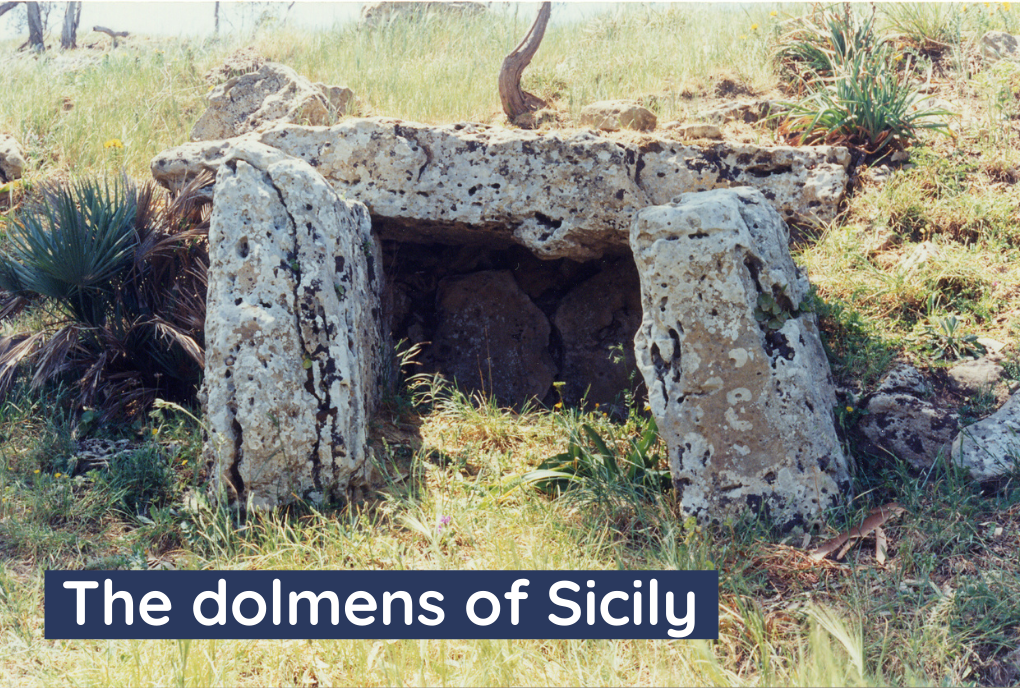
The dolmens of Sicily: studies, characteristics and what they are
Despite being little known, the dolmens of ancient Sicily are testimonies of extraordinary value. In fact, consider that the whole of prehistoric Sicily presents a vast heritage, often unexplored, but which could be used as an opportunity to experience this beautiful land at 360°.
In Sicily, archaeological areas present a clear temporal stratification that is reflected above all in architectural, pictorial and clay features. From east to west of the island, it is possible to admire ruins linked to the funerary context, such as sanctuaries and tombs. Among these are the dolmens.
From the Breton words dol (board) and men (stone), these examples of megalithic architecture are realised through the use of huge stone blocks positioned in such a way as to delimit a quadrangular space. This is achieved by superimposing a horizontal slab on two vertically placed stones.
But how to visit the archaeological sites in Sicily? You should know that in order to enjoy the beauty of these unknown but fascinating finds, there is a new formula that links current tourist trends with a passion for outdoor sports: archaeotrekking. This new way of hiking is geared towards the rediscovery of little-known sites and locations, such as the dolmens of Early Bronze Age Sicily. It consists mainly in the creation of emotional and cultural routes to be taken on foot along the ancient routes used for transhumance and trade. This takes place with the accompaniment of a guide who is an expert in archaeology and who can provide enthusiasts with a unique immersive experience.
So, as you continue reading, you will be able to get all the information you need about these Sicilian archaeological monuments. In particular, you will find information about the following:
- studies and the problem of the origins of Sicily’s dolmens
- where they can be visited.
Studies on the dolmens of Sicily
The pioneer of studies on dolmens in Sicily is archaeologist Salvatore Piccolo. Salvatore is a Sicilian author of several essays on history and archaeology. He has noted how in recent years the island has revealed the presence of these megaliths, albeit smaller in size than the best-known Atlantic examples (see Stonehenge).
His essay “Antiche pietre – La cultura dei dolmen nella preistoria della Sicilia sud-orientale” (‘Ancient Stones – The Dolmen Culture in the Prehistory of South-Eastern Sicily’), was born following the author’s discovery of bone remains and “castellucciana” pottery at the dolmen of Cava dei Servi, inaugurating a new phase in these studies. The work, therefore, stems from the desire to clearly address one of the most original themes related to Sicily, namely the presence of dolmen burials dated to the Sicilian Bronze Age.
In particular, the archaeologist’s commitment to the issue of Sicily’s dolmens is concentrated:
- on defining the origins and characteristics of these architectures, also comparing them with similar presences found in Apulia, Sardinia and Malta, as well as well-known European examples;
- on the description of Sicilian dolmens, having identified four in south-eastern Sicily and two in the western part of the island.
The problem of the origins of Sicilian dolmens
For centuries, the dolmens of Sicily and Europe have been shrouded in an aura of mystery that has given rise to often highly imaginative interpretations. In reality, it should be made clear that these megalithic structures are cultural products of manual skills related to the earliest continental architectural forms.
Consequently, among scholars, the question of the origin of the dolmen phenomenon has arisen spontaneously throughout the Mediterranean basin. In the specific case of Sicily, further difficulties regarding the definition of a certain chronology is generated by the various spietramenti that, in the last century, were caused by agricultural work in the Hyblean region.
According to Salvatore Piccolo, the phenomenon of Sicilian prehistoric megalithism can be placed in a chronological span between the end of the 3rd and the first half of the 2nd millennium BC. This dating was established through the interpretation and analysis of various artefacts he found near dolmens.
The scholar noted that among the different cultural influences that alternated on the sola during the prehistoric period, two, in particular, stand out:
- a European from the north-west
- the other Mediterranean with an oriental matrix.
Since the artefacts of the indigenous Sicilian peoples (Sicans, Siculians and Elymians) are fairly well known, they have automatically been excluded from the origins of the Sicilian dolmen phenomenon. Thus, the origin of Sicily’s dolmens is likely to be attributed to other peoples.
This theory is confirmed by the fact that towards the end of the 3rd millennium B.C., the island’s western side was affected by a cultural wave that led to the emergence of a mercantile hub south-west of Sicily from Sardinia. This was aimed at regulating trade between Trinacria, Sardinia, Spain and the East. Therefore, this explains the presence of local artefacts and phenomena of imitation of certain cultural aspects typical of Western Europe, such as dolmens.
The dolmens of south-eastern Sicily
Of course, one question that is often asked about these architectures and who designed them is how the dolmens were built. The common characteristic of dolmens in Sicily, but also of almost all megalithic dolmen structures, is the use of colossal stone blocks or slabs. The architectures present a trilithic configuration: a horizontal slab superimposed on two straight stones.
This arrangement, therefore, makes it possible to take advantage of structural elements such as a roof and supports that, by intersecting, delimit a well-defined space. Moreover, the balance that is created allows the structure not to collapse.
Each geographical area in Europe also had to deal with the procurement of materials. This had an impact on the size of the monuments. Where the stone was hard, these presented large dimensions. In other contexts where the stone is more malleable, dolmens are smaller in size. This is precisely the case in Sicily and all Mediterranean regions.
Here, moreover, the arrangement along the coastline suggested that the phenomenon had spread by sea, although it also expanded inland.
Mount Bubbonia
Located on a hill to the west of Gela, on a terrace that runs along the eastern side of the hill, the megalithic monument here is rectangular in shape. The rocky materials present there of limestone origin were used for its construction. According to the findings, the dolmen has a chamber of just over 2 metres and must have been a small burial monument. The orientation of the entrance is towards the north-east, which is one of the distinctive features of dolmens in Sicily. The architecture is also associated with prehistoric settlements from the Early Bronze Age.
In the early 20th century, the archaeologist Paolo Orsi first discovered the tomb during an excavation campaign near the ancient 6th-century city of Maktorion. Inside the tomb, he found a small jug with traces of paint that led him to erroneously date the dolmen to the 7th century BC.
A fact that should not be overlooked is that in antiquity, especially among the less affluent social classes, it was customary to use previously used objects. Therefore, finding artefacts from nearby but different eras should not mislead but should be interpreted for the purpose of better determining the Sicilian dolmen phenomenon.
Servants’ Quarry
It lies in the mountainous region of the Monti Iblei, within a Nature Reserve crossed by the Tellesimo torrent, whose course has created deep gorges and sheer walls. Its geological conformation and location have aroused interest since the Copper Age due to flint extraction, which was easily traded as it was useful for making weapons and tools.
The megalithic monument found here is semi-elliptical in shape, consisting of four rectangular slabs driven into the ground, on top of which are three other slabs inclined just enough to simulate a domed roof. Numerous human bone remains and pottery fragments from the Castellucciano period were found in the vicinity, placing the dolmen in the Early Bronze Age. Moreover, these would confirm the burial nature of the artefact and the presence of a genuine dolmen cemetery whose characteristics can be found in other examples in the Mediterranean area.
Lazarus Quarry
The initial section of the so-called Cava Grande di Rosolini, this is one of the quarries in the south-eastern area of Sicily, located between the municipalities of Modica and Rosolini.
On the right side of the quarry, the rock walls are marked by tombs of different types, all from the Castelluccio period. Prominent among them is the famous Tomba del Principe (Prince’s Tomb), with its monumental elevation hollowed out in the limestone rock. A little further west, there is a dolmen in an obvious state of decay. The megalithic remains along the hillside show that instead of stone slabs, two large limestone blocks arranged in a semicircular shape were used.
Moreover, the limestone floor forced the builders to use broad-based megaliths, the remains of which are only visible for a quarter of their height. What is striking is the skill of the builders. To compensate for the unevenness of the left block, two wedges were inserted to straighten the architectural structure. The shaping of the stones suggests the superimposition of an ordered sequence of slabs to form a false dome roof.
The remaining fragments found nearby suggest a funerary construction. In fact, despite the state of abandonment, it was possible to glimpse around the two surviving monoliths, a circular stone enclosure found in other Mediterranean and Atlantic dolmen examples and which would place this architecture between the end of the 3rd and beginning of the 2nd millennium BC.
Avola
Twenty kilometres away from Syracuse, an architectural structure known as the pseudo dolmen of Avola was discovered. Discovered in 1961 by the Sicilian teacher Salvatore Ciancio, this appears to be a trilithic structure, probably created by exploiting a natural cavity.
Convinced that he had found a dolmen find to be protected, the entire area was fenced off, but debate arose among scholars as to its nature, as no excavations were ever carried out to study it. Although some scholars supported Cianci’s theory, others disagreed with it.
On the other hand, Salvatore Piccolo came to the conclusion that it is a pseudo-dolmen, partly a product of nature and partly created by man. Supporting his theory are the analyses carried out by the geologist Giuseppe Ansaldi. From these, the Sicilian archaeologist came to the conclusion that it is a “natural structure that may have been adapted to experiment with architectural elaborations”. It can certainly be argued that the pseudo-dolmen of Avola is nothing more than an attempt to monumentalise a work that nature has created.
The structure consists of a limestone slab resting on two pillars. The various fractures in the slab and its enormous size would have forced the municipal administration to erect three brick supports. On the surface of the slab leaning against the wall, ten small shallow recesses were found that would suggest the burial of children from the early Christian period.
In addition, two grooves run along the eastern slab that join to form a right angle. The hypotheses as to their purpose were the most imaginative and disparate. In the end, Salvatore Piccolo came to the conclusion that they are notches functional for the extraction of a limestone block of about one cubic metre.
The dolmens of western Sicily
In this area of Trinacria, only two dolmen presences are attested:
- at Mura Pregne, east of Monte San Mauro, between Termini Imerese and Sciara
- in Sciacca, in the district of San Giorgio.
The first is formed by four megalithic blocks driven into the ground and a slab as a roof. It has a rectangular ground plan, confirmed by the presence of two slabs that must have concluded the roof.
The second is located east of the bottom of ‘Femmina Morta’. Discovered in 1930, its structural characteristics immediately led to it being catalogued as a dolmen. Several fragments of pottery from the Early Bronze Age have been found in the vicinity, while engravings have been found on some boulders that would suggest the presence of a small sacellum or collecting pits.
by Annapasqua Logrieco





